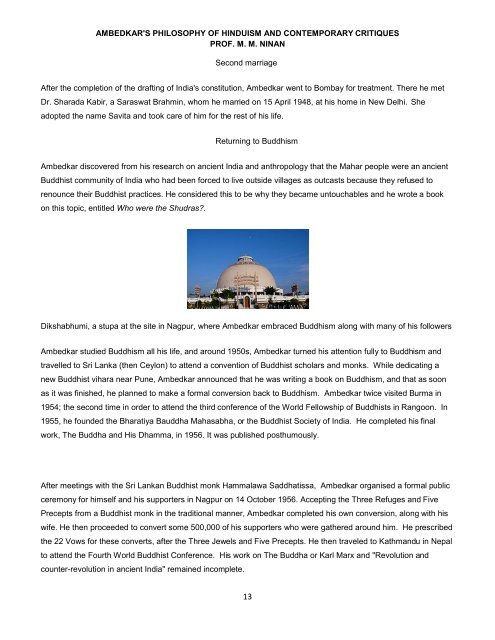Ambedkar-Philosophy of Hinduism
You also want an ePaper? Increase the reach of your titles
YUMPU automatically turns print PDFs into web optimized ePapers that Google loves.
AMBEDKAR'S PHILOSOPHY OF HINDUISM AND CONTEMPORARY CRITIQUES<br />
PROF. M. M. NINAN<br />
Second marriage<br />
After the completion <strong>of</strong> the drafting <strong>of</strong> India's constitution, <strong>Ambedkar</strong> went to Bombay for treatment. There he met<br />
Dr. Sharada Kabir, a Saraswat Brahmin, whom he married on 15 April 1948, at his home in New Delhi. She<br />
adopted the name Savita and took care <strong>of</strong> him for the rest <strong>of</strong> his life.<br />
Returning to Buddhism<br />
<strong>Ambedkar</strong> discovered from his research on ancient India and anthropology that the Mahar people were an ancient<br />
Buddhist community <strong>of</strong> India who had been forced to live outside villages as outcasts because they refused to<br />
renounce their Buddhist practices. He considered this to be why they became untouchables and he wrote a book<br />
on this topic, entitled Who were the Shudras?.<br />
Dikshabhumi, a stupa at the site in Nagpur, where <strong>Ambedkar</strong> embraced Buddhism along with many <strong>of</strong> his followers<br />
<strong>Ambedkar</strong> studied Buddhism all his life, and around 1950s, <strong>Ambedkar</strong> turned his attention fully to Buddhism and<br />
travelled to Sri Lanka (then Ceylon) to attend a convention <strong>of</strong> Buddhist scholars and monks. While dedicating a<br />
new Buddhist vihara near Pune, <strong>Ambedkar</strong> announced that he was writing a book on Buddhism, and that as soon<br />
as it was finished, he planned to make a formal conversion back to Buddhism. <strong>Ambedkar</strong> twice visited Burma in<br />
1954; the second time in order to attend the third conference <strong>of</strong> the World Fellowship <strong>of</strong> Buddhists in Rangoon. In<br />
1955, he founded the Bharatiya Bauddha Mahasabha, or the Buddhist Society <strong>of</strong> India. He completed his final<br />
work, The Buddha and His Dhamma, in 1956. It was published posthumously.<br />
After meetings with the Sri Lankan Buddhist monk Hammalawa Saddhatissa, <strong>Ambedkar</strong> organised a formal public<br />
ceremony for himself and his supporters in Nagpur on 14 October 1956. Accepting the Three Refuges and Five<br />
Precepts from a Buddhist monk in the traditional manner, <strong>Ambedkar</strong> completed his own conversion, along with his<br />
wife. He then proceeded to convert some 500,000 <strong>of</strong> his supporters who were gathered around him. He prescribed<br />
the 22 Vows for these converts, after the Three Jewels and Five Precepts. He then traveled to Kathmandu in Nepal<br />
to attend the Fourth World Buddhist Conference. His work on The Buddha or Karl Marx and "Revolution and<br />
counter-revolution in ancient India" remained incomplete.<br />
13


















